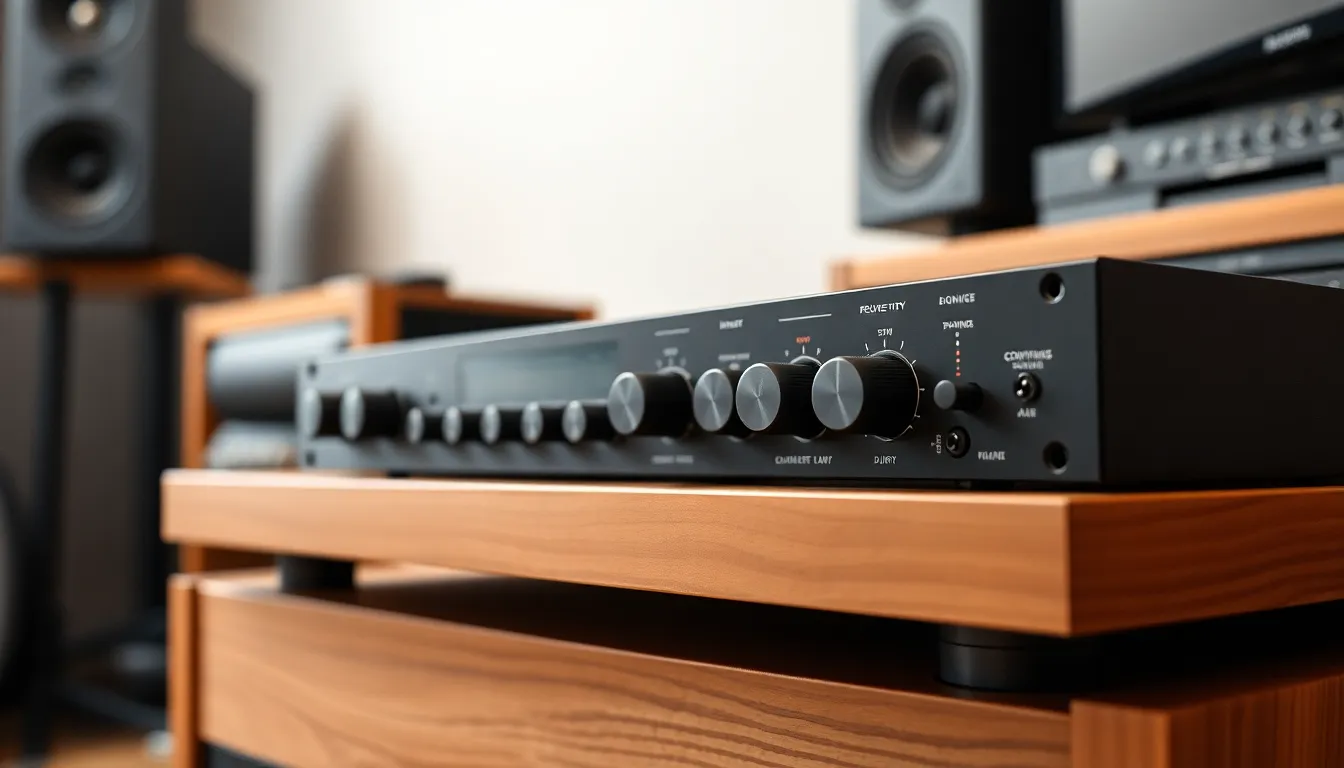In the world of audio, preamp quality is the unsung hero that can make or break a sound system. Imagine trying to enjoy your favorite tunes only to be met with a muddy mix that sounds like it’s been recorded in a tin can. Not exactly the concert experience one hopes for! A good preamp transforms those signals, making music sparkle and vocals shine.
But it’s not just about turning up the volume. The right preamp can elevate every note, ensuring that every whisper of a guitar and every drumbeat hits just right. If you think all preamps are created equal, think again. Investing in quality can be the difference between a mediocre jam session and an audio experience that leaves you dancing in your living room. So, let’s dive into the world of preamps and discover what makes them the secret sauce of superior sound.
Table of Contents
ToggleUnderstanding Preamp Quality
Preamp quality plays a vital role in audio performance. A well-designed preamp enhances sound clarity and preserves the integrity of the audio signal.
What Is a Preamp?
A preamp, short for preamplifier, amplifies low-level audio signals before sending them to a power amplifier. It captures audio input from various sources, such as microphones and instruments. After adjustment, it boosts the signal to a usable level. Different types of preamps exist, including tube, solid-state, and digital models, each offering unique sound characteristics. Understanding these variations helps consumers choose the right preamp for their system.
Importance of Preamp Quality
Quality preamps improve overall sound reproduction. High-quality components reduce noise and distortion, which is essential for achieving a clean signal. Poor-quality preamps can introduce unwanted artifacts, leading to muddier sound. Investing in a quality preamp enhances the listening experience by providing greater dynamic range and frequency response. Music professionals prioritize preamp quality to ensure accurate sound capture in studio settings. For everyday listeners, a good preamp enriches audio enjoyment during home listening sessions.
Factors Affecting Preamp Quality

A few critical factors influence preamp quality. Understanding these elements helps in selecting the right preamp for optimal audio performance.
Design and Build Quality
Build quality significantly impacts a preamp’s performance and durability. Robust materials often determine how well a preamp can withstand daily use. A well-designed chassis can minimize interference, which enhances sound clarity by reducing noise. Components like knobs and connectors contribute to user experience and functionality. Aesthetic choices also play a role, influencing the visual appeal of audio setups. Every aspect of a preamp’s design can affect signal integrity, ultimately shaping audio output.
Components Used
Components inside a preamp determine sound characteristics and overall effectiveness. High-quality capacitors and resistors are essential for preserving audio fidelity. Depending on the preamp type, tube or solid-state components will produce distinct sonic signatures. Each type offers unique advantages; tube preamps deliver warmth while solid-state models provide reliability and accuracy. Operational amplifiers must also be of high quality to ensure low distortion levels. The synergy among all these components influences the richness and clarity of the audio signal.
Evaluating Preamp Quality
Evaluating preamp quality involves both subjective listening tests and objective technical measurements. Each method offers unique insights into performance and sound characteristics.
Listening Tests
Listening tests assess a preamp’s audio performance through direct comparison. Audiophiles and professionals often conduct blind tests to distinguish nuances in sound. Participants might evaluate clarity, frequency response, and dynamic range. Rich sound with minimal distortion indicates superior quality. Listening in different environments, such as studios or home setups, provides valuable context. Variations in sound perception can arise from personal preferences. A high-quality preamp enhances vocal presence and instrument separation, enriching the overall experience.
Technical Measurements
Technical measurements provide quantitative data about preamp performance. Parameters such as frequency response, total harmonic distortion, and signal-to-noise ratio offer clear insights. Frequency response indicates how well a preamp handles audio signals across the spectrum. High-quality preamps typically show flat frequency response within audio ranges. Total harmonic distortion measures sound fidelity, with lower values indicating less coloration. Signal-to-noise ratio assesses background noise levels, representing the cleanliness of the output. These metrics collectively highlight differences in preamp designs and capabilities, guiding informed decisions for audio enthusiasts.
Common Myths About Preamp Quality
Many misconceptions exist regarding preamp quality. Addressing these myths helps clarify the importance of selecting the right preamp for optimal audio experiences.
Myths vs. Reality
One common myth suggests that all preamps sound the same. In reality, audio characteristics vary significantly between tube and solid-state preamps. Some believe that buying the cheapest option suffices, but lower-quality preamps often introduce unwanted noise and distortion. Many audiophiles think digital models outperform all others, yet each design serves different needs and preferences. Misunderstandings about price sometimes lead people to think expensive models automatically guarantee superior performance, but value depends on proper integration with existing equipment and personal listening preferences.
Clarifying Misconceptions
A frequent misconception involves the belief that only high-end preamps produce a noticeable difference in audio quality. Budget-friendly models might surprise users with their performance when designed well. Another widespread idea is that preamp features, like multiple inputs, determine overall quality. However, the design of internal components, such as capacitors and operational amplifiers, plays a crucial role. Some users also think that more expensive components always equal better sound, but synergy within the entire audio system impacts overall performance more than individual piece quality.
Investing in a quality preamp is essential for anyone serious about audio fidelity. It can elevate the entire listening experience by enhancing clarity and reducing distortion. The right preamp not only preserves the integrity of the audio signal but also complements the overall sound system.
Understanding the various types of preamps and their unique characteristics allows consumers to make informed choices that align with their preferences. Whether opting for a tube or solid-state model, the goal remains the same: achieving the best possible sound.
Ultimately, the synergy between a high-quality preamp and other audio components is what truly transforms an ordinary listening session into an extraordinary one. Prioritizing preamp quality can make a significant difference in how music is experienced and enjoyed.

